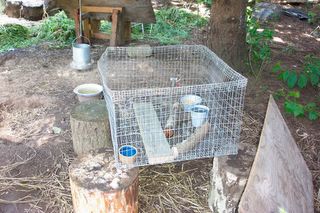
You might be wondering exactly why we have a cage in the chicken run when we refer to our hens as truly free range. This is our "Broodiness Discouragement Cage".
A hen goes "broody" when they decide to lay on a clutch of eggs, as if to hatch them. The hen will fluff up her feathers to elevate her body temperature, and pluck her breast bare to keep the eggs warm and humid. With modern breeds this natural motherhood drive has in many cases been bred out of the hens, and sometimes if hens go broody they don't always sit until the chicks pip out. Certain breeds and types of chickens (such as bantams) are noted for their fine mothering skills, but not all hens possess this anymore.
In our situation especially, without a rooster, our chickens will
never hatch out a clutch of eggs. But still, they get broody. Increasing amounts of daylight can bring this on, and perhaps some breeds are more sensitive to this tendency than others. About a month ago, two of our hens, Puja, a black Australorp, and Goldie, a Buff Orpington went broody--and stayed broody!
When a hen goes broody, they rarely leave their nest, although ideally they leave the nest once a day to eat, drink water, and poop (usually the largest chicken poop you have ever seen in your life, but that might be more detail than some would like). So for chickens without a rooster, or with a mothering instict that has been bred away or into a flawed form of what nature intended, it can actually be a big deal if they go broody and stay that way. We heard from both the extension service and several feed stores that hens can starve to death or dehydrate.
We also heard numerous methods to discourage broodiness, including dunking the chicken in water, or submerging their head. Now, I don't know what people are thinking, because chickens can catch cold and die if they get wet and then chilled, and I refuse to believe that submerging anyone's head in water against their will would be useful. We had also heard that putting broody hens in a cage that was suspended from a branch or beam so it could swing would dispell broodiness. That sounded about as fun as vomiting on a ride at the county fair.
Let me be the first to tell you that hens can be treated humanely, it's a great thing to lead with. We decided after researching it and asking for more information on the broody cycle that the most important thing was that the hen's body temperature had to be reduced in order to disrupt the hormonal cycle that was telling these hens to sit on the nest until they had chicks pipping out. So we took our two broody hens, and put them in a 3.5' X 3.5' cage, which we hoisted on 4 stumps. They had ample food and water, and we weighted a piece of plywood over the top so they couldn't get out.
The wire bottom cage prevented the hens from keeping their body temperature elevated. At night we put the hens in the coop of course, and after two days the broody cycle was disrupted! We expect the formerly broody hens will go into a molt nearly immediately, and maybe resume laying eggs in a month or more.
Today Puja and Goldie were out with the rest of the chickens--although periodically Puja or Goldie would wander back into the coop and check out the nests. Michael or I would quickly open the coop door, and say to formerly broody hens, "Oh no you don't! Don't you even look at that nest! Get back out side or we're putting you back in the cage!"





